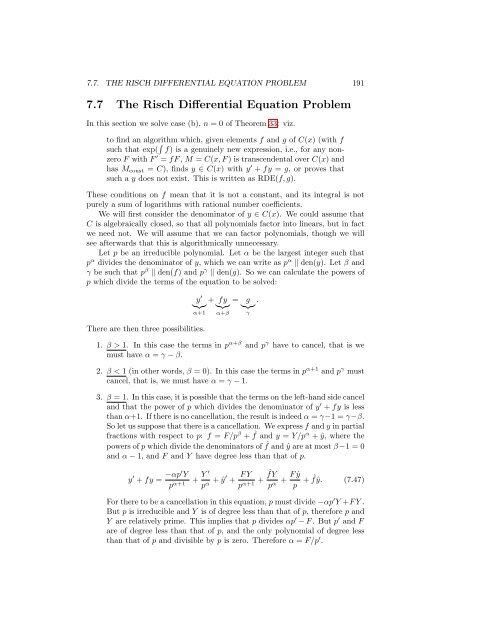Contents - Student subdomain for University of Bath
Contents - Student subdomain for University of Bath
Contents - Student subdomain for University of Bath
You also want an ePaper? Increase the reach of your titles
YUMPU automatically turns print PDFs into web optimized ePapers that Google loves.
7.7. THE RISCH DIFFERENTIAL EQUATION PROBLEM 191<br />
7.7 The Risch Differential Equation Problem<br />
In this section we solve case (b), n = 0 <strong>of</strong> Theorem 33: viz.<br />
to find an algorithm which, given elements f and g <strong>of</strong> C(x) (with f<br />
such that exp( ∫ f) is a genuinely new expression, i.e., <strong>for</strong> any nonzero<br />
F with F ′ = fF , M = C(x, F ) is transcendental over C(x) and<br />
has M const = C), finds y ∈ C(x) with y ′ + fy = g, or proves that<br />
such a y does not exist. This is written as RDE(f, g).<br />
These conditions on f mean that it is not a constant, and its integral is not<br />
purely a sum <strong>of</strong> logarithms with rational number coefficients.<br />
We will first consider the denominator <strong>of</strong> y ∈ C(x). We could assume that<br />
C is algebraically closed, so that all polynomials factor into linears, but in fact<br />
we need not. We will assume that we can factor polynomials, though we will<br />
see afterwards that this is algorithmically unnecessary.<br />
Let p be an irreducible polynomial. Let α be the largest integer such that<br />
p α divides the denominator <strong>of</strong> y, which we can write as p α ‖ den(y). Let β and<br />
γ be such that p β ‖ den(f) and p γ ‖ den(g). So we can calculate the powers <strong>of</strong><br />
p which divide the terms <strong>of</strong> the equation to be solved:<br />
y ′<br />
}{{}<br />
α+1<br />
There are then three possibilities.<br />
+ fy<br />
}{{}<br />
α+β<br />
= g<br />
}{{}<br />
γ<br />
1. β > 1. In this case the terms in p α+β and p γ have to cancel, that is we<br />
must have α = γ − β.<br />
2. β < 1 (in other words, β = 0). In this case the terms in p α+1 and p γ must<br />
cancel, that is, we must have α = γ − 1.<br />
3. β = 1. In this case, it is possible that the terms on the left-hand side cancel<br />
and that the power <strong>of</strong> p which divides the denominator <strong>of</strong> y ′ + fy is less<br />
than α+1. If there is no cancellation, the result is indeed α = γ−1 = γ−β.<br />
So let us suppose that there is a cancellation. We express f and y in partial<br />
fractions with respect to p: f = F/p β + ˆf and y = Y/p α + ŷ, where the<br />
powers <strong>of</strong> p which divide the denominators <strong>of</strong> ˆf and ŷ are at most β−1 = 0<br />
and α − 1, and F and Y have degree less than that <strong>of</strong> p.<br />
.<br />
y ′ + fy = −αp′ Y<br />
p α+1 + Y ′<br />
p α + ŷ′ + F Y ˆfY<br />
+<br />
pα+1 p α<br />
+ F ŷ<br />
p + ˆfŷ. (7.47)<br />
For there to be a cancellation in this equation, p must divide −αp ′ Y +F Y .<br />
But p is irreducible and Y is <strong>of</strong> degree less than that <strong>of</strong> p, there<strong>for</strong>e p and<br />
Y are relatively prime. This implies that p divides αp ′ − F . But p ′ and F<br />
are <strong>of</strong> degree less than that <strong>of</strong> p, and the only polynomial <strong>of</strong> degree less<br />
than that <strong>of</strong> p and divisible by p is zero. There<strong>for</strong>e α = F/p ′ .












![[Luyben] Process Mod.. - Student subdomain for University of Bath](https://img.yumpu.com/26471077/1/171x260/luyben-process-mod-student-subdomain-for-university-of-bath.jpg?quality=85)



